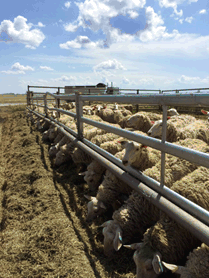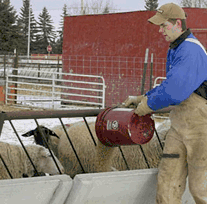| |  With tight business margins and the need to manage costs sheep producers are always on the look-out for ways to reduce feed costs. There can be opportunities for local, alternative feed sources. With tight business margins and the need to manage costs sheep producers are always on the look-out for ways to reduce feed costs. There can be opportunities for local, alternative feed sources.
Alternative feeds often become available as new markets open up for crops. The opportunity for a different feed source can vary from late season grazing of grass seed, grain crop stubble regrowth to the residue from a human food product like field corn, sugar beets or potatoes to the residue, or by-product, of a local processor.
Canola or grain screenings, potato waste, grass seed cleanings and beet pulp are by-products that can be used to feed sheep. Different feeds can be available when a traditional feed ingredient is processed locally into another product, such as the alfalfa fines from an alfalfa cubing plant. By-products such as brewer’s grain or bakery waste can sometimes be sourced from local food or beverage manufacturing. Screenings can be available when grains, legumes, or forage seeds are cleaned.
It is vitally important to know the availability, supply and price of any product before incorporating it into your flock feeding program.
Some products are only available through contracts or on specific terms set by the seller. By-products are often only available at certain times of the year.
In order to utilize these feeds you need to know:
- your long term feed requirements, how many days of feed for how many sheep
- your ability to handle, store (sometimes large amounts of) these feeds
- how to store different feeds (i.e. to avoid mould) to maintain quality
- how to feed your sheep for maximum feed quality, nutritional benefit and minimum waste
- the proximity of your farm in relation to location of the by-product feed source so you can accurately determine accessibility and cost
- how much to order to minimize switching feeds in rations and to reduce trucking costs
Before purchasing and feeding any non-traditional product or by-product have a sample tested to determine the nutrient content.
This is critically important for every new batch whether a feed product is used regularly or being added as a new feed ingredient. The nutrient and moisture contents of by-product feeds vary dramatically with different loads depending on the supplier, the product itself, processing methods, harvesting methods, the season and the weather. Differences in climate, soil conditions, plant maturity, plant variety and field management factors all influence nutrient content and, ultimately, the value of any feed. Agriculture & Forestry has a listing of Feed and Water testing laboratories, videos on sampling feeds as well as Frequently Asked Questions on testing feed http://www1.agric.gov.ab.ca/
You can’t afford feeds or rations that don’t meet the nutritional needs of the sheep.
The nutritional value of every feed, the minerals, protein and energy, need to be monitored and balanced in a complete ration that maintains consistent animal performance whether reproduction, milk production or lamb growth.
SheepBytes ration balancer software (www.sheepbytes.ca) was developed to assist producers manage flock nutrition and feed costs. It has a feed library that includes some alternative and by-product feeds. Use the software to develop rations. Monitor animal body condition, feed intake and waste. Get advice. Work with your feed company nutritionist.
Alternative and by-product feeds can be very different to feed.
Although some by-product feeds can be comparable in nutrient content to more commonly used feedstuffs, sheep may not perform the same:
- There can be “anti-nutritional factors” that reduce palatability, lower feed intake and reduce animal performance because of bitter taste (mustard seed), excessive fines (dust) or high levels of oil (canola). Some screenings can have high levels of toxins due to ergot (grains), erucic acid, glucosinolates (mustard, canola seeds).
- Always be cautious when feeding different or by-product feeds. It is critically important to monitor the performance of your flock. Are the sheep eating the ration well, cleaning up the feed? Is body condition score changing in sample sheep (i.e. old ewes, replacement ewe lambs)? Is the feed maintaining quality – is there any mould or heating?
- With any feed it’s important to introduce it slowly over a week and then increase the amount of the new feed. With some by-product feeds it can be even more important to go slowly. Increase by-product levels in the ration gradually over a two-week period.
- The high-moisture content of some by-product feeds may limit intake and result in poor animal performance. Food-processing wastes like wet brewer’s grain contain large amounts of water (75-80%). Be aware that you could be buying a lot of water.
- High moisture and warm weather provide good growing conditions for yeasts and moulds. High moisture feed products have to be used quickly so quality does not deteriorate.
- The water content also makes some feeds expensive to transport, very difficult to store and more difficult to feed. Food-processing wastes like wet brewer’s grain contain large amounts of water (75-80%).
 Storage and handling can be challenging. Many by-product feeds are sold in bulk form and delivered by the truck or semi-trailer load. Some products bridge if stored in grain bins making access and feeding difficult. Pole sheds with tractor/loader access may be needed to keep the product out of the weather. Storage and handling can be challenging. Many by-product feeds are sold in bulk form and delivered by the truck or semi-trailer load. Some products bridge if stored in grain bins making access and feeding difficult. Pole sheds with tractor/loader access may be needed to keep the product out of the weather.
- You also need to consider the type of feeding system you use on your operation. A feeding system must allow you to easily and thoroughly incorporate all feed stuffs into the ration and then efficiently deliver it to your sheep. Labour is usually the second highest cost in producing market lambs. A ‘cheaper’ feed that is laborious and time-consuming to feed might not be the right choice.


Evaluating By-Product Feeds
- Sample and feed test all feed products.
- Weigh the feed product – bushel weights under 12 kg. / 25 lbs. indicate a high amount of chaff and low energy content. Bushel weights over 23 kg. / 50 lbs. may cause acidosis.
- Visually examine for dust, ergot, mould, weed seeds and foreign materials.
- Smell – musty or foul odours indicate deterioration that impacts nutritional value, palatability and feed intake.
- Combine physical evaluations of any and all feed products feed test results to reliably determine the nutritive value and usefulness of the feed.
- Develop a balanced ration for every group of sheep being fed.
For more information, contact:
Ag-Info Centre – 310-FARM
Table of More Common By-product Feeds
|
|